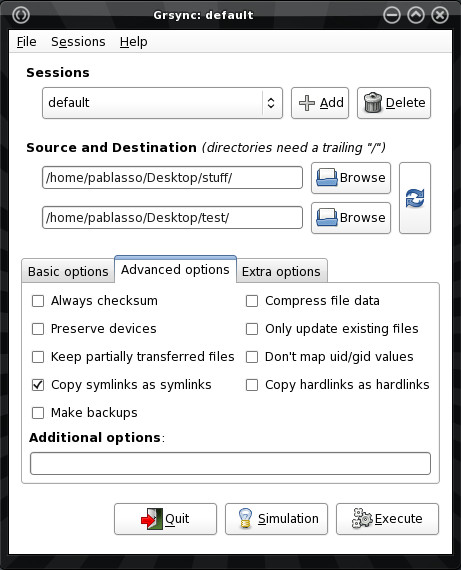

- GRSYNC EXPORT AS RSYNC SCRIPT HOW TO
- GRSYNC EXPORT AS RSYNC SCRIPT INSTALL
- GRSYNC EXPORT AS RSYNC SCRIPT SOFTWARE
- GRSYNC EXPORT AS RSYNC SCRIPT PASSWORD
Number (default 636) instead of the regular LDAP port number, and If you are using TLS/SSL, specify the TLS/SSL (LDAPS) port Permission to write the configuration information, usually theĬonfiguration directory administrator, and if you are using security
GRSYNC EXPORT AS RSYNC SCRIPT PASSWORD
(default 389), the suffix, the DN and password of a user having To do so, theįollowing information about the configuration server is required: the Set up or create with the configuration server. If you have already set up aĬonfiguration directory server, you should register any servers you This information is used by the console and administration server toĬonfigure and manage your servers. Server information is stored in the configuration directory server. System Group : ldapuser # Enter LDAP group name (It is same as username) System User : ldapuser # Enter Ldap username which we created earlier If you have not yet created a user and group for the servers,Ĭreate this user and group using your native operating Will give this user/group some permissions in specific paths/files It is strongly recommended that this user should have no privileges The servers must run as a specific user in a specific group. General.FullMachineName=Ĭomputer name : # Press ENTER With the following command line option to specify the hostname: You would rather not wait, hit Ctrl-C and run this program again Warning: This step may take a few minutes if your DNS serversĬan not be reached or if DNS is not configured correctly. On which you're setting up server software. To accept the default shown in brackets, press the Enter key.Įnter the fully qualified domain name of the computer Recommended for experienced server administrators only. Useful for quickĪllows you to specify common defaults and options.Īllows you to specify more advanced options. Would you like to continue? : # Press EnterĪllows you to quickly set up the servers using the mostĬommon options and pre-defined defaults.
GRSYNC EXPORT AS RSYNC SCRIPT SOFTWARE
The following output is a report of the items found that need toīe addressed before running this software in a productionģ89 Directory Server system tuning analysis version 23-FEBRUARY-2012. Your system has been scanned for potential problems, missing patches,Įtc. Would you like to continue with set up? : # Press Enter Type "Control-C" to cancel the setup program Type "Control-B" then "Enter" to go back to the previous screen Press "Enter" to choose the default and go to the next screen It is recommended that you have "root" privilege to set up the software. This program will set up the 389 Directory and Administration Servers.
GRSYNC EXPORT AS RSYNC SCRIPT INSTALL
Make sure you have added EPEL repository and run the following command to install 389 DS server: yum install 389-ds-base 389-admin Configure 389 Directory serverĪfter installing it, run the following command to configure our LDAP server. Restart the CentOS server to take effect all changes. Set password for the new user.: passwd ldapuser Create a LDAP user accountĬreate a new user called ldapuser. Sample output: _keepalive_time = 300Įdit /etc/security/nf file: vi /etc/security/nfĪdd the following lines at the bottom: * soft nofile 8192Įdit /etc/pam.d/login file: vi /etc/pam.d/loginĪdd the following line at end: session required /lib/security/pam_limits.so To do so, edit /etc/nf file : vi /etc/nfĪdd the following lines: _keepalive_time = 300 We have to do some security tuning tweaks to enhance the performance of the LDAP server. To install EPEL repository, run: yum install epel-release Tweak system performance and security tuning So, let us add and enable EPEL repository to install 389 ds. firewall-cmd -reload Add EPEL repositoryģ89 ds is not available in the CentOS official repositories. Restart firewalld service to save the changes. To do so, run the following commands one by one: firewall-cmd -permanent -add-port=389/tcp firewall-cmd -permanent -add-port=636/tcp firewall-cmd -permanent -add-port=9830/tcp We need to allow LDAP server's default ports via firewall or router in order to access the LDAP server from a remote system. ::1 localhost localhost.localdomain localhost6 localhost6.localdomain6ġ92.168.1.150 server 127.0.0.1 localhost localhost.localdomain localhost4 localhost4.localdomain4 Configure FQDN in /etc/hosts fileĮnter your server's fully qualified domain name. You can skip this if you intend to use the LDAP server in your local area network.
GRSYNC EXPORT AS RSYNC SCRIPT HOW TO
Refer this link to know how to records in DNS server. Make sure you have the IPA address and FQDN of your CentOS server in DNS server.


 0 kommentar(er)
0 kommentar(er)
